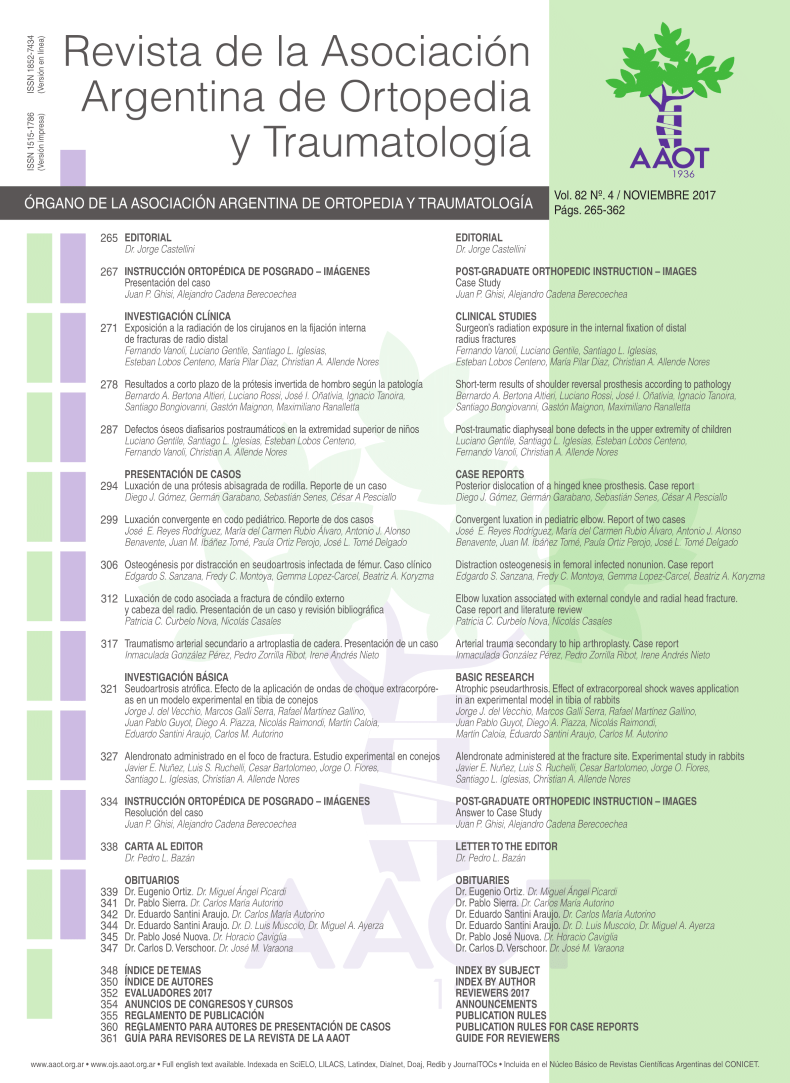Defectos óseos diafisarios postraumáticos en la extremidad superior de niños. [Post-traumatic diaphyseal bone defects in the upper extremity of children].
Contenido principal del artículo
Resumen
Descargas
Métricas
Detalles del artículo

Esta obra está bajo licencia internacional Creative Commons Reconocimiento-NoComercial-CompartirIgual 4.0.
La aceptación del manuscrito por parte de la revista implica la no presentación simultánea a otras revistas u órganos editoriales. La RAAOT se encuentra bajo la licencia Creative Commons 4.0. Atribución-NoComercial-CompartirIgual (http://creativecommons.org/licenses/by-nc-sa/4.0/deed.es). Se puede compartir, copiar, distribuir, alterar, transformar, generar una obra derivada, ejecutar y comunicar públicamente la obra, siempre que: a) se cite la autoría y la fuente original de su publicación (revista, editorial y URL de la obra); b) no se usen para fines comerciales; c) se mantengan los mismos términos de la licencia.
En caso de que el manuscrito sea aprobado para su próxima publicación, los autores conservan los derechos de autor y cederán a la revista los derechos de la publicación, edición, reproducción, distribución, exhibición y comunicación a nivel nacional e internacional en las diferentes bases de datos, repositorios y portales.
Se deja constancia que el referido artículo es inédito y que no está en espera de impresión en alguna otra publicación nacional o extranjera.
Por la presente, acepta/n las modificaciones que sean necesarias, sugeridas en la revisión por los pares (referato), para adaptar el trabajo al estilo y modalidad de publicación de la Revista.
Citas
2. Sales de Gauzy J, Fitoussi F, Jouve JL, Karger C, Badina A, Masquelet AC. Traumatic diaphyseal bone defects in children. Orthop Traumatol Surg Res. 2012; 98(2):220-6.
3. Ring D, Allende C, Jafarnia K, Allende BT, Jupiter JB. Ununited diaphyseal forearm fractures with segmental defects: plate fixation and autogenous cancellous bone-grafting. J Bone Joint Surg. 2004; 86: 2440-45.
4. Hope PG, Cole WG. Open fractures of the tibia in children. J Bone Joint Surg Br 1992;74—B:546—53.
5. Buckley SL, Smith G, Sponseller PD, Thompson JD, Griffin PP. Open fractures of the tibia in children. J Bone joint Surg Am 1990;72—A:1462—9.
6. Keating JF, Simpson AHRW, Robinson CM. The management of fractures with bone loss. J Bone Joint Surg Br 2005; 87-B: 142-150.
7. Liu HC, Hsu CC. Regeneration of a segmental bone defect after acute osteomyelitis due to an animal bite. Injury 2004;35:1316—8.
8. Sales de Gauzy J, Vidal H, Cahuzac JP. Primary shortening followed by callus distraction for the treatment of a post- traumatic bone defect. J Trauma 1993;34:461—3.
9. Rigal S, Merloz P, Le Nen D, Mathevon H, Masquelet AC. Bone transport techniques in posttraumatic bone defects. Orthop Traumatol Surg Res 2012; 98: 103-108.
10. Karger C, Kishi T, Schneider L, Fitoussi F, Masquelet AC. Treatment of posttraumatic bone defects by the induced membrane technique. Orthop Traumatol Surg Res 2012; 98: 97-102.
11. Allende C, Allende BT. Posttraumatic one-bone forearm reconstruction. A report of seven cases. J Bone Joint Surg. 2004; 86A: 364-9.
12. Papakostidis C, Bhandari M, Giannoudis PV. Distraction osteogenesis in the treatment of long bone defects of the lower limbs. Effectiveness, complications and clinical results; a systematic review and meta-analysis. Bone Joint J. 2013; 95B: 1673-80.
13. Nusbickel FR, Dell PC, McAndrew MP, Moore MM. Vascularized Autografts for Reconstruction of Skeletal Defects Following Lower Extremity Trauma. A Review. Clin Orthop Relat Res. 1989;243:65-70.
14. Masquelet AC, Begue T. The concept of induced membrane for reconstruction of long bone defects. Orthop Clin North Am 2010; 41: 27-37.
15. Allende C, Mangupli M, Bagliardelli J, Diaz P, Allende BT. Infected nonunions of long bones of the upper extremity: staged reconstruction using polymethylmethacrylate and bone graft impregnated with antibiotics. Chir Organi Mov 2009; 93: 137-142.
16. Hinsche A, Giannoudis PV, Matthews SE, Smith RM. Spontaneous healing of large femoral cortical bone defects: does genetic predisposition play a role?. Acta Orthop Belg 2003;69:441-446.
17. McKibbin B. The biology of fracture healing in long bones. J Bone Joint Surg 1978; 60-B: 150-162.
18. Keating JF, Simpson AHRW, Robinson CM. The management of fractures with bone loss. J Bone Joint Surg 2005; 87-B:m142-150.
19. Malizos KN, Papatheodorou LK. The healing potential of the periosteum molecular aspects. Injury 2005; 36: S13-9.

